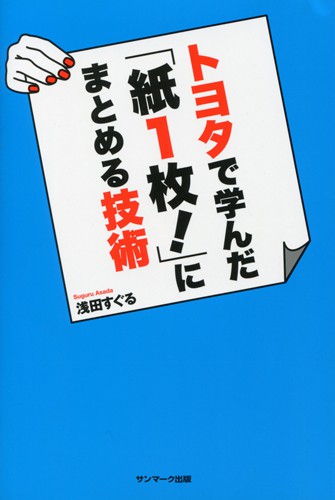


ISBN978-4-7631-3411-0
210 pages / February 2015 / 1,400 yen (w/o tax)
Superior thinking and organizational skills made simple, based on the work ethic of Toyota, one of the world's top companies.
At Toyota, the world’s largest automobile corporation, there is one basic thing that all employees take for granted. It is the practice of consolidating all necessary information into a single piece of paper. It is the approach to preparing everything from meeting minutes and business trip reports to business proposals and meeting materials on a single piece of A3 or A4 size paper. Within the company, this practice contributed to the betterment of information distribution, smoother communication, and more efficient problem solving which, according to the author, helped build Toyota — with its workforce of some 70,000 people — into the leading enterprise that it is. The author himself worked for Toyota, a company that is recognized as the nation’s best. He accumulated an abundance of experience from working for the company, where he learned that your strengths and capabilities at work can be enhanced through continuous trial and error. Drawing from the essence of the “1 page” approach that he learned there, he has developed an organizational system that can be applied to various work-related settings.
“Work is a continuous process…”
“The proposal was rejected…”
“I’m having trouble explaining this…”
This book provides an extremely effective method for getting rid of such stresses in one fell swoop. Try it out for yourself.
– What Toyota employees do without fail at every meeting
– Get your thoughts organized with the “1 page” approach
– How to bring your yearly overtime hours down from 400 to 0
– Transform “ask” into “action”
– Which is more efficient, typing or writing by hand?
– What is the key to being organized?
– Anybody can communicate logically using the “three questions”
– The essence of the “1 page” approach is to maintain forward motion at work
– Ask “How?” five times rather than asking “Why?” five times
– The goal is to be able to work without the use of paper
My favorite key term introduced in this book is “transparency.” Consolidate everything down to one page. If you do this, you can clearly see the whole picture at a glance. It’s a simple concept, but once I tried putting the author’s methods into practice, even the briefest of meeting notes were significantly easier to follow when looking back at them afterwards. Without changing the essence of my message, I greatly improved my organizational skills by following the methods introduced in this book. I want readers to experience that same sense of satisfaction and achievement.
